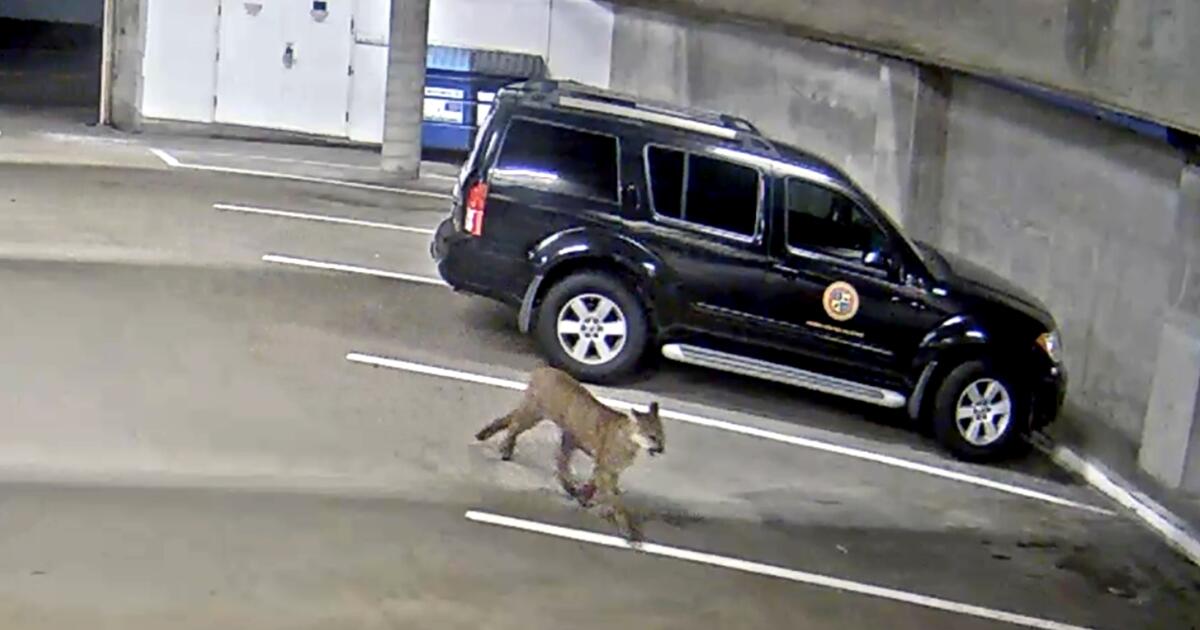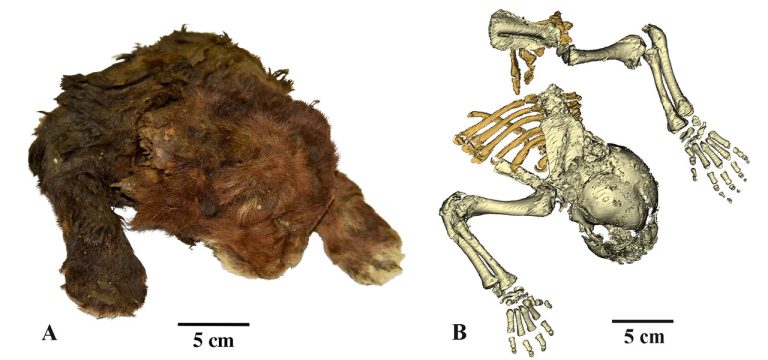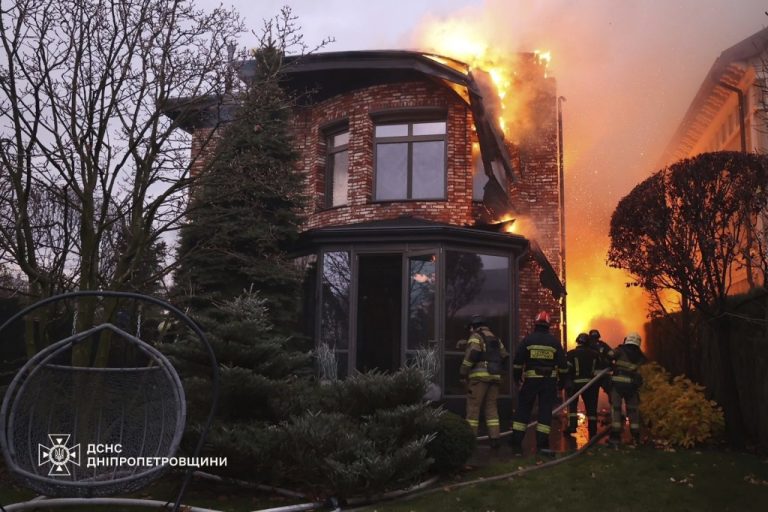
Why didn’t anyone capture and relocate the mountain lion that slid through downtown Oceanside for several days last week?
It is a relevant question after a vehicle struck and killed a mountain lion on North River Road, about eight miles northeast of the downtown neighborhoods where the first sightings were made.
Wildlife officials have maintained that — absent DNA evidence or distinctive markings — there is no proof that the suspected male juvenile cat killed March 8 was the same one seen roaming along sidewalks closer to the beach.
But the public, as social media posts attest, largely believes they were one and the same.
The lion’s downtown visit triggered immediate love from the public, which started posting a flurry of memes that started with hilariously absurd sightings of the cougar surfing near the Oceanside Pier or attacking an In-N-Out burger. But those tributes quickly turned somber as news of the crash surfaced, with one local artist posting an AI-generated rest in peace image of a mountain lion in an Oceanside hat laying a rose on a second lion lying under a shroud behind crime scene tape.
Suddenly, that security camera footage of an apex predator hustling through a City Hall parking garage as if late for a meeting with the mayor looks a little different. This surreal dash becomes a little cringeworthy after the crash, knowing that these spaces meant for vehicles carry significant risk for animals.
Dangerous environment
Regardless of whether it was the same lion, the situation illustrates the fact that when a wild animal ends up in an urban area, a clock starts ticking. The longer wildlife is traveling city streets, the more likely it is that they will have a fatal encounter with an automobile.
Those charged with protecting wildlife and the public know this. It is standard operating procedure, experts said in interviews last week, to begin trying to capture and relocate mountain lions when they are repeatedly sighted in places with no clear path of retreat to the wildlife areas whence they came.
That was certainly the case for the Oceanside mountain lion.
Tim Daly, an information officer for the California Department of Fish and Wildlife, said in an email last week that when the sightings started, the agency assigned a specialist “in hopes of finding the lion, capturing it, and then returning it to the nearest suitable habitat.”
“Unfortunately, we were not able to catch up with the animal, and so the capture possibility just didn’t present itself,” Daly said.
But is it really that hard to locate and capture a mountain lion? As one Facebook commenter said: “The fish and game should have darted it and taken it to the wilderness.”
Getting that job done is not so simple, said Winston Vickers, a wildlife research veterinarian and director of the California Mountain Lion Project at UC Davis.
Using satellite-enabled tracking collars, the project studies the movements of multiple mountain lions to better understand their habits, especially how they use what little habitat remains among Southern California’s endless suburban sprawl.
Over many years, tracking has proven just how mobile mountain lions truly are. Often, they may roam several miles in a single night. This presents massive problems for any capture effort.
“The first problem is, how are you going to catch up to them?” Vickers said. “A colleague of mine once had a collared mountain lion that went from the south rim of the Grand Canyon, down to the bottom, swam the river, and went half-way up the north side in two hours.”
Deciding where to sit and wait in a busy cityscape for a lost mountain lion to come wandering by, he said, is pretty much impossible. If they’re in a city, he said, they’re generally looking to escape and are unlikely to start following a set routine from one night to the next.
Darts: Easier said than done
Even if a game warden armed with a tranquilizer dart gun happened to station him or herself in precisely the right spot to see a lion come stalking by, they likely would not take the shot. Dart guns, Vickers noted, use bursts of air, not exploding gunpowder, to shoot their sedative-filled projectiles.
“Those darts travel much more slowly than a bullet, so it takes much more time, a second or two, for them to reach the target,” Vickers said. “Normally, you’re not going to take a shot, especially in the dark, unless you’re sure the animal will remain still because, if you hit it in the wrong spot, it could kill the animal.”
Wildlife biologist Kevin Brennan, now in private consulting but previously having worked for the Department of Fish and Wildlife, recalled two cases where darts shot at cats were fatal. One, he recalled, occurred beside the 210 freeway in Los Angeles County.
“They had been chasing after this lion throughout the early morning hours, and it was right by the edge of the freeway; they took the shot because it could have run out and caused an accident,” Brennan said. “They ended up killing the animal because the dart didn’t hit it in the hindquarters.”
That location, he explained, is preferred because of its large mass of muscle tissue, which can safely absorb sedation drugs. Another scenario in Temecula, he said, involved a mountain lion that sat down in a parking lot within sight of a trained game warden who decided to take the shot.
“Sometimes those darts have a tendency to corkscrew in flight, and that’s what this one did, it ended up spinning as it went toward the animal,” Brennan said. “It landed in the back of the ribcage and punctured a lung.
“That animal died.”
Using darts, both Vickers and Brennan said, is generally only effective in cases where mountain lions essentially trap themselves in a situation that forces them to become stationary targets.

Now retired, California Department of Fish and Game Wildlife Biologist Kevin Brennan carries a young mountain lion from a Redlands backyard in 2007.
(Greg Vojtko)
“I think it’s 100 percent of the time, as far as I’ve ever heard of or known of, that they are somehow spotted in a location, usually like a walled garden or a pet dog has chased him up a tree in a backyard, that you’re able to dart them,” Vickers said.
While it certainly would not have been pleasant for the Oceanside lion or the homeowner who made the discovery, wandering into the wrong backyard was the scenario most likely to result in relocation.
What about using traps?
Metal traps baited with a dead deer are another effective way to capture mountain lions, and it’s the method that Vickers’ team uses in wildlands to collar and release the lions that UC studies track.
Fish and Wildlife, Daly said, considered using such a “box” trap, one with a mechanism that closes a door when an animal walks inside, to nab the Oceanside lion. But the operation, he said, never got to the point where deploying one had a high probability of success.
“We didn’t have strong information on the exact location of the lion at a particular time,” Daly said. “We wouldn’t have known where to put a trap.
“Also, it’s very rare for a mountain lion to go into a trap if it has other options for places to move around.”
Vickers, who co-published a research paper that compared several methods of mountain lion capture, said that urban trapping is much more difficult than in the wild where lions patrol defined hunting grounds.
While it can be assumed that a baited trap in a known hunting grounds will likely be visited by a passing cougar, there is much less certainty in developed areas, which have variable patterns of noise, scent and human activity.
Trapping in cities or towns is generally most successful, he said, if a lion is observed frequenting a well-defined area.
“If they were being sighted repeatedly in a certain neighborhood, you would use a roadkill deer to attract them and, if they walk by, typically these young males are hungry, and they’ll stop and feed,” Vickers said.
It can be difficult, he added, to get neighbors’ buy-in on stationing traps baited with deer carcasses in public areas. But it can work. The technique, he said, was once successful in Mission Viejo when a young male was repeatedly spotted in and around a greenbelt that provided a workable setting for a trap.
“It’s not impossible, but it’s way more difficult than it sounds,” Vickers said.
Brennan agreed. While he said that Vickers and his colleagues have drastically improved trapping techniques over the years, it’s still difficult to get the job done in an urban areas. Logistics are a significant part of the difficulty. Trappers must get permission from all land owners within a fixed distance of each trap. Sometimes, as in a trapping operation in Redlands, getting that permission is not easy.
“You would have vacant homes or you wouldn’t know who the owner of a certain piece of property was, so that limits your opportunities for setting a trap,” Brennan said. “The best spot might be one you couldn’t use if somebody didn’t want a trap near their home.”
The public, it seems, has come to terms with the likelihood that the Oceanside lion probably died. As commenters Nadia and Anthony Salce stated in a recent Facebook post: “Know that we wanted you to live your best life, and you did, shortly. May the wind be in your sail and the heavens provide many fish or small creatures to hunt freely.”






